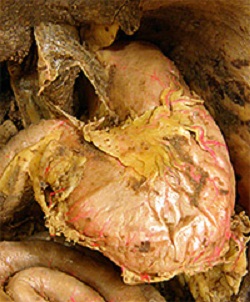
Description
The stomach is a muscular, hollow, dilated part of the digestion system which functions as an important organ of the digestive tract in some animals, including vertebrates, echinoderms, insects (mid-gut), and molluscs. It is involved in the second phase of digestion, following mastication (chewing).
Function
Bolus (masticated food) enters the stomach through the oesophagus via the oesophageal sphincter. The stomach releases proteases (protein-digesting enzymes such as pepsin) and hydrochloric acid, which kills or inhibits bacteria and provides the acidic pH of two for the proteases to work. Food is churned by the stomach through muscular contractions of the wall called peristalsis – reducing the volume of the fundus, before looping around the fundus and the body of stomach as the boluses are converted into chyme (partially digested food). Chyme slowly passes through the pyloric sphincter and into the duodenum of the small intestine, where the extraction of nutrients begins. Depending on the quantity and contents of the meal, the stomach will digest the food into chyme anywhere between forty minutes and a few hours. The human stomach can hold approximately 1.5 litres of food.
Colour
Clear with whatever the colour of the food contents.
Shape
A "J" shaped pouch.
Location
The stomach is located in the upper left of the abdomen between the esophagus and the small intestine sitting just below the diaphragm.
The stomach is a muscular, hollow, dilated part of the digestion system which functions as an important organ of the digestive tract in some animals, including vertebrates, echinoderms, insects (mid-gut), and molluscs. It is involved in the second phase of digestion, following mastication (chewing).
Function
Bolus (masticated food) enters the stomach through the oesophagus via the oesophageal sphincter. The stomach releases proteases (protein-digesting enzymes such as pepsin) and hydrochloric acid, which kills or inhibits bacteria and provides the acidic pH of two for the proteases to work. Food is churned by the stomach through muscular contractions of the wall called peristalsis – reducing the volume of the fundus, before looping around the fundus and the body of stomach as the boluses are converted into chyme (partially digested food). Chyme slowly passes through the pyloric sphincter and into the duodenum of the small intestine, where the extraction of nutrients begins. Depending on the quantity and contents of the meal, the stomach will digest the food into chyme anywhere between forty minutes and a few hours. The human stomach can hold approximately 1.5 litres of food.
Colour
Clear with whatever the colour of the food contents.
Shape
A "J" shaped pouch.
Location
The stomach is located in the upper left of the abdomen between the esophagus and the small intestine sitting just below the diaphragm.
 RSS Feed
RSS Feed
